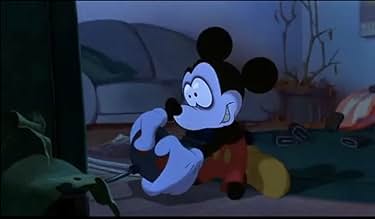AVALIAÇÃO DA IMDb
7,3/10
1,4 mil
SUA AVALIAÇÃO
Adicionar um enredo no seu idiomaIn an attempt to convince Minnie that he hasn't forgotten to buy her an anniversary present, Mickey Mouse ends up promising to take her to Hawaii.In an attempt to convince Minnie that he hasn't forgotten to buy her an anniversary present, Mickey Mouse ends up promising to take her to Hawaii.In an attempt to convince Minnie that he hasn't forgotten to buy her an anniversary present, Mickey Mouse ends up promising to take her to Hawaii.
- Indicado a 1 Oscar
- 1 indicação no total
Wayne Allwine
- Mickey Mouse
- (narração)
Russi Taylor
- Minnie Mouse
- (narração)
Kelsey Grammer
- Dr. Frankenollie
- (narração)
Jim Cummings
- Monster
- (narração)
Bill Farmer
- Pluto
- (narração)
Sheb Wooley
- Dying Enemy
- (sonoplastia)
- (não creditado)
Enredo
Você sabia?
- CuriosidadesThe character name 'Dr. Frankenollie', besides the obvious Frankenstein reference, is also a reference to legendary Disney animators Frank Thomas and Ollie Johnston. He was originally going to be named Dr. X, Dr. XX, or Dr. XXX (like the villain from O Médico Louco (1933), but were forced to avoid doing so.
- Citações
[Mickey is completely strapped into a chair]
Mickey Mouse: Talk about your ironclad contract.
- ConexõesFeatured in Mickey: Reelin' Through the Years (1995)
Avaliação em destaque
"Runaway Brain" was an attempt (or so the Disney studio announced before its release) to recapture the spirit of the earlier Mickey Mouse cartoons - not the series involving the dull suburbanite which fizzled out with "The Simple Things" in 1953, but the lively everymouse of the 1930s. But here's what they forgot: the banal Mickey Mouse cartoons c.1940-1953 were ALSO an attempt to recapture the spirit of the earlier Mickey Mouse cartoons. And THAT was an attempt made by the very same animators, writers etc. who had worked on the originals not long before. (The original directors, admittedly, had mostly either left the studio or gone on to work on features. The director of the later Mickeys was usually Charles Nichols, who HADN'T been responsible for the earlier ones, which makes him an easy target for blame - but some of his Mouseless cartoons, like "The Legend of Coyote Rock" and "Wonder Dog", show that he was a formidable talent, if not by the standards of his day, then certainly by the standards of ours.) If THESE people couldn't resurrect Mickey Mouse, what made Chris Bailey, with no prior credits at all (at least according to the IMDb), think that HE'D be able to?
The truth is that the charm of Mickey's earlier cartoons, while undeniable, is highly elusive. In one of his last great triumphs, the Oscar-winning "Brave Little Tailor" (1938), Mickey battles a giant, in a climax that ISN'T played for laughs, even though it has some comic touches. Ditto "Runaway Brain". But the danger of the earlier cartoon is real; the danger here is completely fake. The Gothic mad science of "The Mad Doctor" (1933) or "The Worm Turns" (1937) was not violated by the inclusion of a giant cartoonish rodent; here, no particular atmospheric effect even gets a chance to establish itself. The sometimes over-deliberate pacing of the earlier cartoons somehow failed to hurt them in the least. Here, the overly zippy pacing is fatal. What's wrong with "Runaway Brain"? In a sense, EVERYTHING. It's a complete failure.
In order to create GOOD new Mickey Mouse cartoons, Disney will have to set up a semi-autonomous short subjects unit and force it to churn out, say, twelve cartoons a year, of whatever kind strikes the animators' fancy, and hope against hope that in some years' time there will emerge a heroic cartoon director who feels strong enough to tackle the Mouse. Such a short cartoons unit would of course make a guaranteed, substantial loss, EVERY year, and I don't blame Disney for baulking at the idea. But it's the only way.
The truth is that the charm of Mickey's earlier cartoons, while undeniable, is highly elusive. In one of his last great triumphs, the Oscar-winning "Brave Little Tailor" (1938), Mickey battles a giant, in a climax that ISN'T played for laughs, even though it has some comic touches. Ditto "Runaway Brain". But the danger of the earlier cartoon is real; the danger here is completely fake. The Gothic mad science of "The Mad Doctor" (1933) or "The Worm Turns" (1937) was not violated by the inclusion of a giant cartoonish rodent; here, no particular atmospheric effect even gets a chance to establish itself. The sometimes over-deliberate pacing of the earlier cartoons somehow failed to hurt them in the least. Here, the overly zippy pacing is fatal. What's wrong with "Runaway Brain"? In a sense, EVERYTHING. It's a complete failure.
In order to create GOOD new Mickey Mouse cartoons, Disney will have to set up a semi-autonomous short subjects unit and force it to churn out, say, twelve cartoons a year, of whatever kind strikes the animators' fancy, and hope against hope that in some years' time there will emerge a heroic cartoon director who feels strong enough to tackle the Mouse. Such a short cartoons unit would of course make a guaranteed, substantial loss, EVERY year, and I don't blame Disney for baulking at the idea. But it's the only way.
- Spleen
- 24 de abr. de 2002
- Link permanente
Principais escolhas
Faça login para avaliar e ver a lista de recomendações personalizadas
Detalhes
Contribua para esta página
Sugerir uma alteração ou adicionar conteúdo ausente

Principal brecha
By what name was Mickey e seu Cérebro em Apuros (1995) officially released in Canada in English?
Responda
























